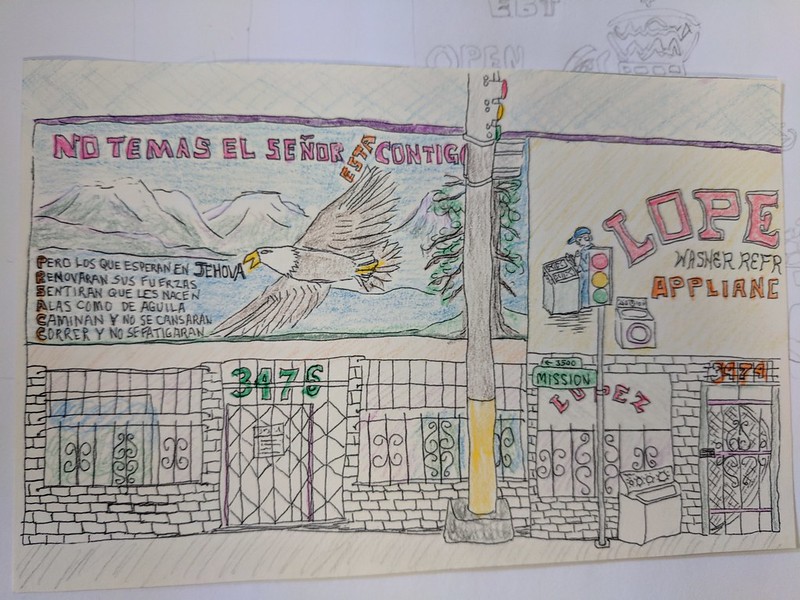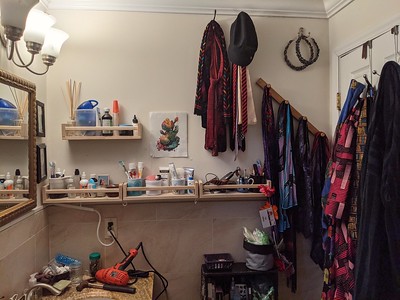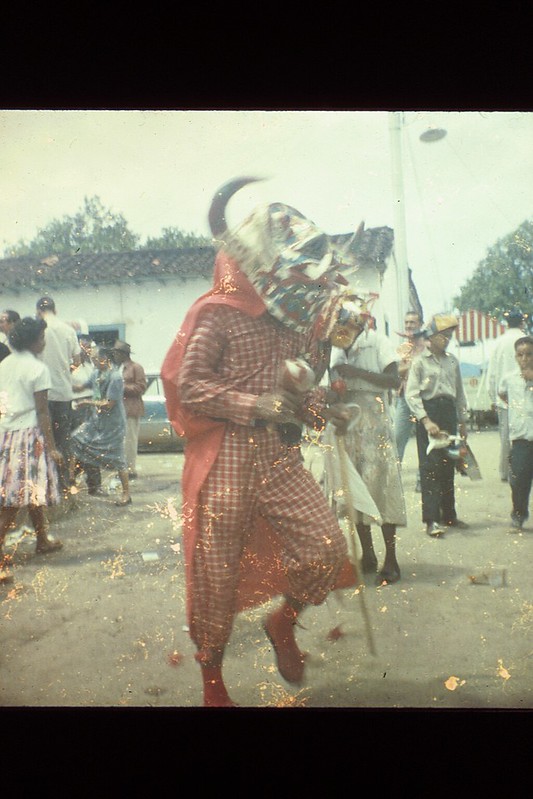While researching my family tree I have come across some interesting characters. From just a few records over the years, I try to construct a picture of someone’s life two hundred years ago. I look up the siblings, look up the neighbors, speculate, write emails to random 4th cousins, and bring it all together with solid sources.
My grandmother Esther’s parents emigrated as teenagers with their parents and siblings around 1911, all from a very specific area of Lancashire. I’ve done some work researching each branch of her family.
Here’s a chart that shows an overview of the people I’m going to write about in my next few posts.

Here’s as much as I can tell about Jenny Cumpsty, one of my 4th great-grandmothers, and her daughter Jennet, tracing them and their descendents down to people in living memory. They’re the great-grandmother & grandmother of Caroline Crane from the chart above.
From studying Jenny’s family a bit further back and further onwards, it’s clear she was right on the cusp of the family’s transition from a life of agricultural labor, out in the sticks, to one of industrial work centered around growing urban areas.
For many generations, this branch of the family lived in The Fylde – an area just north of Preston, east of Blackpool, and west of Garstang – This is north of what is now Greater Manchester, south of Morecambe Bay. The land is mostly a peat bog, a lot of it below sea level.

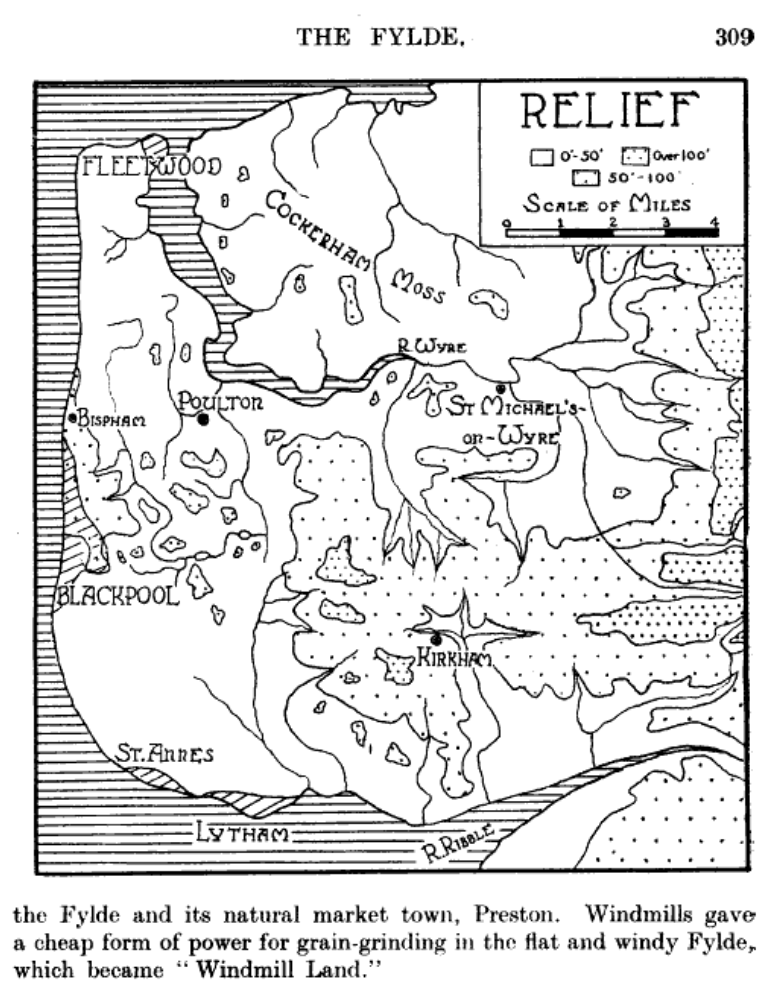
Most of this branch of family were from Pilling and Stalmine. There was not even a road to Pilling until 1806. Just to set the scene, let’s read a bit about the famous Bog Burst of 1745 and the general feeling of this area of The Fylde, north of the Wyre River — Cockerham Moss.
The Pilling Moss Bog Burst of 1745 involved the eruption of the raised mire now known as Rawcliffe Moss, following a period of exceptional rain, but was probably also due to human activity, both from long-term peat-digging and also because of more recent land drainage and improvement for agriculture. More than 40 hectares of farmland were inundated, in places covered in peat up to five metres deep. Property was damaged, but no casualties were reported. Enclosure and drainage after 1830 have ensured that nothing similar can happen again.
The mosses, mosslands or raised mires of lowland Lancashire have always been a noteworthy aspect of the local landscape, in the literature often carrying more than a hint of menace. Thus William Camden [in 1637] wrote of the presence in Lancashire of ‘certaine moist places and unwholsome called Mosses’
– from The Pilling Moss Bog Burst of 1745, William D. Shannon, Contrebis 2018 v36.
Charles de Rance, a geologist, reported in the 1870s that a local proverb said, ‘Pilling Moss, like God’s grace, is boundless’. He adds, ‘this area is very thinly inhabited, and those who live in the area are, I am informed, often subject to idiotcy and rheumatism’.
The folk of Pilling, near Cockersand Abbey, had the legal right for many centuries to take stone from an outcropping in the sands just offshore, Wet Arse Scar; this right came into dispute in 1808.
Histories of the area north of the Wyre are mostly lists of the architectural features of its churches, and heraldry of the families who owned the land on which my ancestors were hapless peasants grubbing in the mud in their clogs and smocks.
Jenny was born in May 1804 in Mains in the parish of Kirkham to James, a husbandman, and his wife Sarah Kea (Key, or Kaye). (Perhaps a distant relative of John Kay who invented the flying shuttle!) Jenny was christened 17 Jun 1804 in the parish church at Poulton le Fylde (St. Chad’s).
Her father was born in Stalmine, and her mother in Hambleton. Mains, (or Maynes, or Means) Hall was a manor in Singleton which had been owned by the Hesketh family. It is in Kirkham parish, just west of Singleton and east of Poulton-le-Feeylde — right across the Wyre river from Hambleton. Jenny’s family may have been tenants on Hesketh land. Oats, barley, potatoes, and wheat were grown in this area; there were also dairy cows and sheep.
The following paragraph is from a history of a village a few miles south, on the Ribble River, describing farming families overlooking a busy road on the weekend. Though the area is not exactly correct — a more populated towns south of the Wyre — and there wasn’t a major road near Jenny’s family, I like the picture it draws of the farmers of the Fylde in their aprons and clogs.
Farming families used to stand en masse in their fields, adjoining the main road, getting their entertainment from the constant stream of traffic passing through the village at weekends, dressed in their hessian ‘Brats’ (sacking aprons) and clogs. The ‘grannies’ wore beautifully made cotton sun bonnets, intricately tucked, generally heliotrope colour and most becoming!
Another history of village life in The Fylde says,
The flat Fylde landscape was a desolate and remote area in early history and remained visited by few outsiders until the arrival of the railway. There are still vivid memories among the older inhabitants of collies sent north by rail from Welsh farms to start work on the Fylde and of calves wrapped in sacks with just their head protruding and bearing a forwarding address label.
The River Wyre, which dissects the Fylde, was a barrier between the communities of this small piece of coastal flatland but occasionally families did move across the river boundary.
During Mr Lee’s research he heard of a family who made every effort to ensure their children were safe during the hazardous journey across the tidal reaches of the River Wyre.
“They put their children into milk churns to make sure they were sufficiently immobilised to keep them safe and prevent them from falling overboard!” says Mr Lee.
Mains, Kirkham Parish
Back to our young family and Jenny’s birth in 1804 in Mains.
Jenny was the third of eight children. It seems likely she was named after her mother’s mother, Jennet Walker of Hambleton. Her name is sometimes listed as Jane, Jain, Jennet, or Jenny; surname Cumpsty, Compsty, or Compstive. In the image of her christening record below, you can find Jenny listed on the right, 5th entry down.
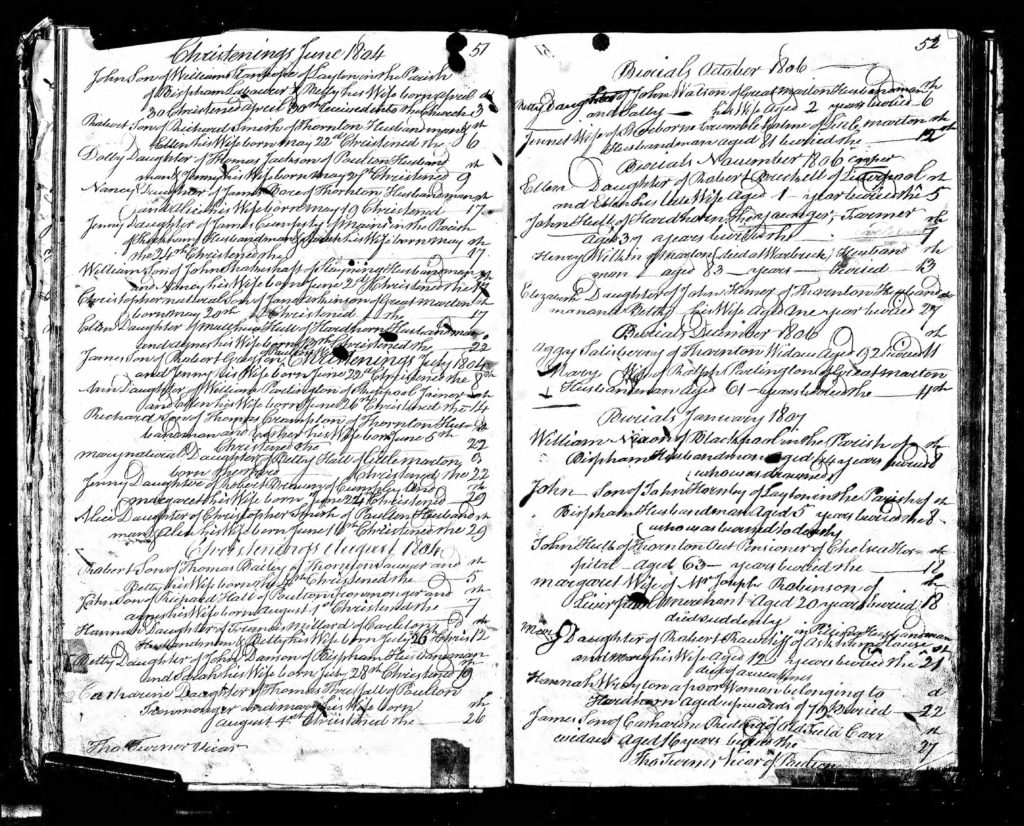
The British Census began in 1801, but all I have currently are birth, marriage, and death records for the early years of Jenny’s life. Still, we can construct something of a picture of her home life from her siblings’ births, and imagine her growing up as part of this large farming family.
In 1810, Jenny was 6 years old. Her older brother John was 11; her sister Alice was 8. Younger siblings were Richard, 4, and Peggy, the baby.
In 1816, Jenny was 12. John was 17, Alice, 14. Her younger siblings were Richard, 10; Peggy, 6; Sarah, 3; and James, the baby.
Hambleton
In 1820 Jenny was 16 years old. Her younger siblings were Richard, 14; Peggy, 10; Sarah, 7, James, 4, and Henry, the baby. The older children were born in Mains, while Henry was born in Hambleton.
It looks to me as if the family all moved to Hambleton between 1816 and 1820, perhaps to be near Jenny’s mother, Sarah Key’s, family. Enclosure was starting to affect more of The Fylde as landowners drained, fenced, and marled the peat bogs. But I don’t know why they left Mains. If I look look at which of their relatives were in Hambleton at that time, from birth, christening, marriage, and burial records, it may give clues, so I’ll try that later.
A little tidbit about Hambleton:
Dr. Charles Leigh of Singleton, writing about 1700, states that the River Wyre ‘affords us a pearl fishing, which are frequently found in large mussels, called by the inhabitants Hambleton Hookins, from their manner of taking them, which is done by plucking them from their skeers or beds with hooks.
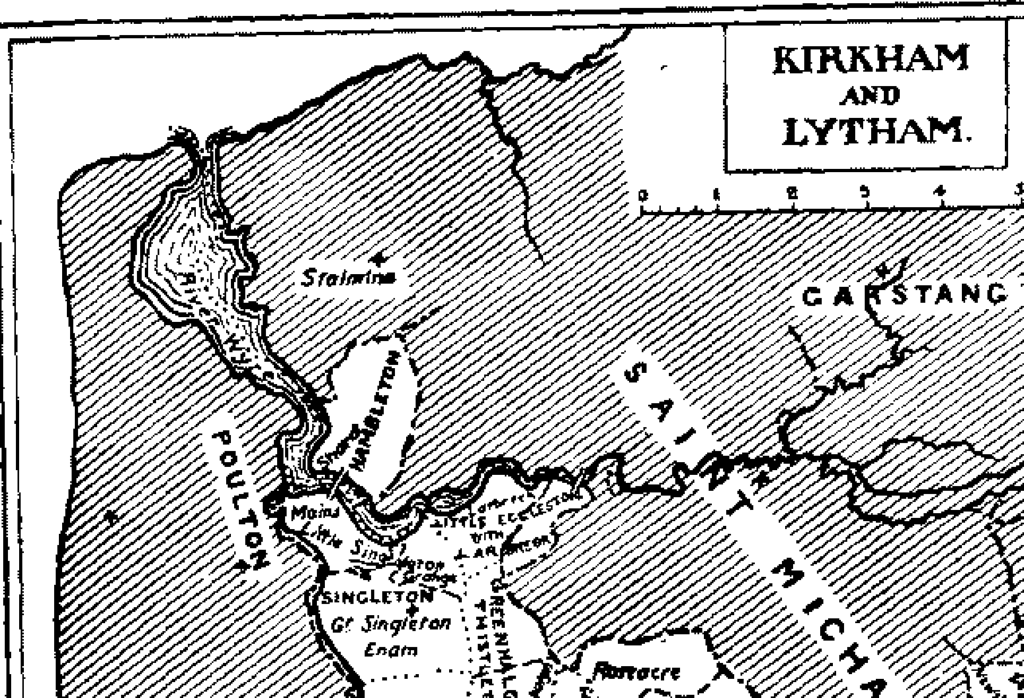
In 1821 her oldest brother John married Nancy Green. They had a son, Richard, in 1823.
In 1824-1825, Peggy, James, and Henry died in Hambleton. Perhaps it was cholera. Whatever happened with the family that moved them across the Wyre to Hambleton, it may not have been a positive change, since within 5 years of their move, several of the younger children died. It must have been a grim time for 20 year old Jenny Cumpsty, spinster. And when she is called a spinster, it seems likely she literally was spinning by hand since the region was known for its textile production.
Stalmine
In June 1825, at age 25, Jenny married William Dobson of Stalmine, Moss Side. Stalmine was (and is) a small village on the Wyre river just north of Hambleton. The “moss side” was to the east of the village, away from the river and the port, and closer to the wild lands of the peat bog — here, the Pilling Moss. In the 1820s, enclosure and drainage of the Moss continued, which meant that more and more of the land & its resources that had been in common use by nearby villagers was now owned, managed, and rented as private property.
A local detail: “A curious wooden track of split oak trees laid on birchwood scrub, known as Kate’s Pad or the Dane’s Pad, crosses the moss. Pollen tests have established that it pre-dates Roman times. Farmers have dug up trees of 50 ft in length.”
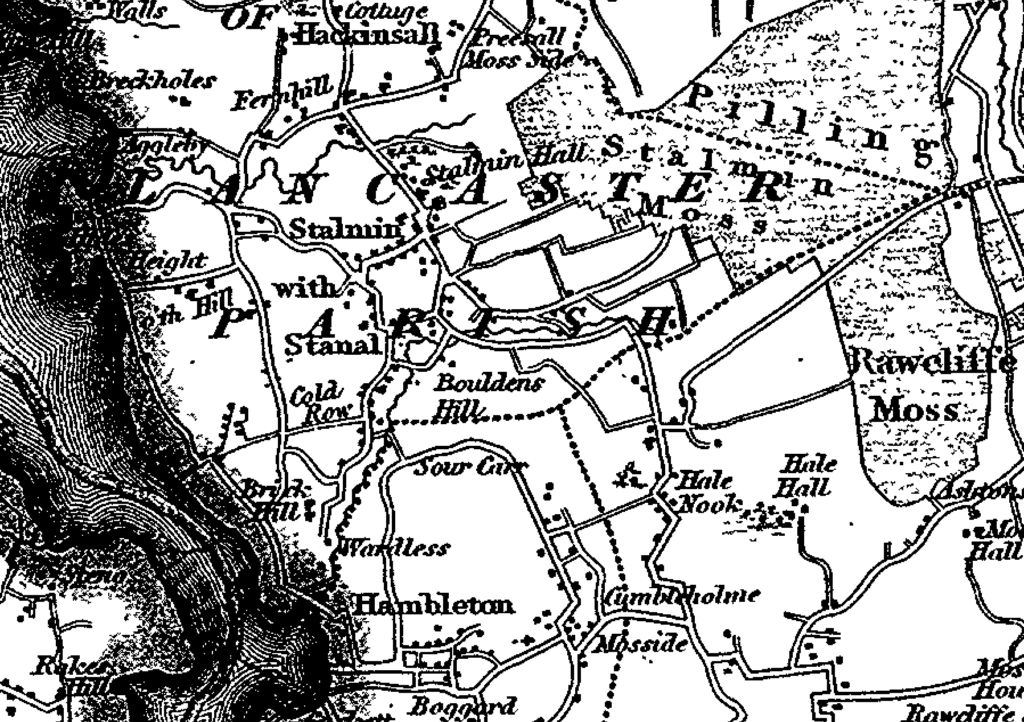
Jenny and William’s marriage was in Kirkham parish (not sure exactly where). Grace Compstive was a witness, likely one of Jenny’s relatives. The other witness was William Fairclough. Neither Jenny nor William could write their names – same with their witnesses – you can see their names are all in the curate’s handwriting, with “X – his mark” or “X – her mark”.
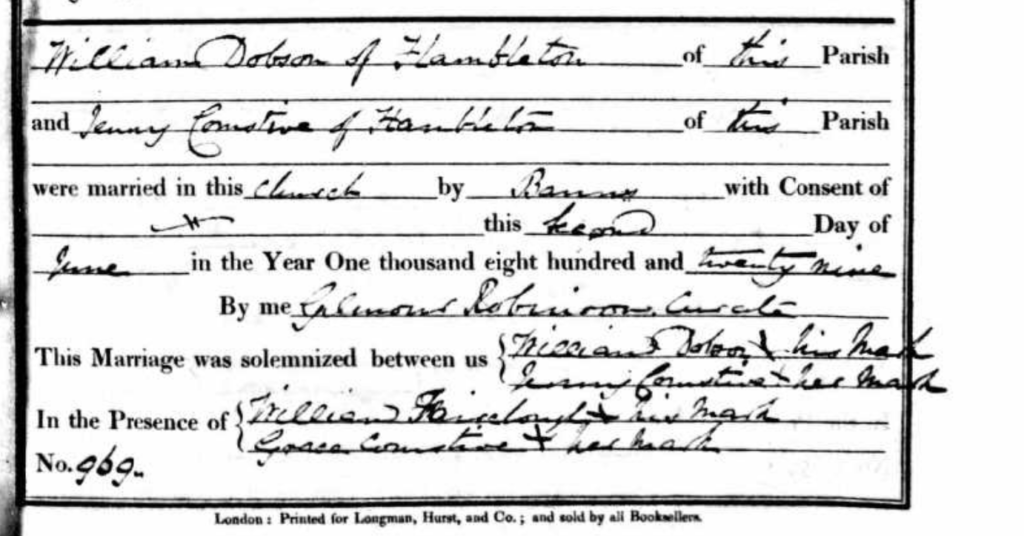
Jenny and William had three children, John, James, and William. They lived in Stalmine Moss Side. I have not found any evidence of William’s profession.
In April 1835, Jenny’s husband William died. She was left widowed with an infant and two small children under age 6.
In October 1837, banns were read for Jenny’s marriage to John Charnley, a 40 year old lath cleaver — and widower — in Stalmine. However, John and Jenny did not marry. Jenny was born 9 months after the initial banns were read, and her sister Sarah 18 months later.
Four months after Sarah’s birth, in 1841, John Charnley married Nancy Wilson. What a cad!
Later in their lives, both Sarah and Jenny used William Dobson’s last name, like their older siblings.
Jenny Cumpsty was listed in the 1841 Census under her birth name, as a 35 year widow living in Hambleton with her 5 small children, John, James, William, Jennet, and Sarah. Jenny’s occupation is simply listed as “Pauper”.
Notice in the census record that she lived near to James Roskell and his family. And William Fairclough, who witnessed her first marriage, was another neighbor.
Out Rawcliffe

In 1850 Jenny married John Roskell, older brother of her neighbor James. John was a widower with children, a blacksmith in Out Rawcliffe. He also owned a small farm, and could write his name.
We can see Jenny in the 1851 Census, now married, living in Out Rawcliffe with her husband the blacksmith, her stepson Robart, 15 and an apprentice to his father; her new 5 month old baby John; her youngest daughter Sarah Dobson (really daughter of John Charnley and born out of wedlock.)
In 1851, Jenny’s older daughter Jennet Dobson, my 3rd great-grandmother, was 12, working as a house servant for a family in Nether Wyresdale. We’ll come back to Jennet, but for now let’s stick with her mother.
In 1861, Jenny and her husband John Roskell the blacksmith were now 60 and 57 years old, still lived in Out Rawcliffe. Sarah, Jenny’s daughter, still lived with them at age 20, along with her half brother John, age 10, still in school. Jenny’s mother Sarah Cumpsty, age 87, also lived with them.
Now it gets upsetting. In Feb. 1862, John Roskell was imprisoned in Preston for 9 months for “carnally knowing a girl above the age of 10 years and below the age of 12 years”. He died in 1862.
What did Jenny do to survive? What happened to Sarah, and to John Roskell junior, still a child?
(I looked – And John worked as an agricultural laborer on nearby farms until his marriage in 1877 – his daughter Elizabeth gone in 1881 to live with her uncle, Jenny Cumpsty’s son William Dobson – and I see John Roskell in the 1901 census back on a farm as an unmarried servant, a cattleman. Because of his father’s imprisonment and death, he didn’t have the chance to become a blacksmith like his older brothers did.)
Jenny’s mother Sarah Cumpsty died in 1864, age 90.
In 1868 Jenny married Sylvester Tomlinson in Garstang. Clearly, she could get it. She died shortly after, aged 64.
I see her as a tough survivor of tough times.
Jennet
Back to Jenny’s daughter Jennet Dobson, my 3rd great-grandmother.
Jennet must have had a difficult childhood, as an illegitimate daughter of an impoverished widow in a small village. When her mother remarried in 1850, Jennet was 11 or 12, and she may have already been in service.
By 1851, at age 12, Jennet Dobson was in service for a farm family in Nether Wyresdale. That was probably a good thing, since her new stepdad John Roskell ended up convicted of being a child molester. The household where Jennet worked (Burn’s Farm) consisted of John Burn, 41, farmer of 104 acres; Ellenore Burn, 36; John Walker, 18, farm servant; Jane Dobson, 12, house servant; Ann Burn, 5, scholar; Jane Burn, 9 months. I picture them as a modestly well off small family with two young children, able to hire and support two extra workers in their household.
Ten years later, Jennet is working for what looks like a more wealthy family, the Heskeths of Upper Rawcliffe With Tarnacre, at Tarnacre Lane. That household was Thomas Hesketh, 74, “Farmer”; his son James, 33 and wife Emma, and their two young daughters. They had 4 servants, Jennet as the “house servant”, two 19 year old men and a 14 year old boy.
In 1863, Jennet married William Crane, a tailor, in Garstang. I’d like to see the parish record of that marriage to find out who stood up as witnesses for the young couple. That may give some clue to how they met.
10 years later, in the 1871 census, Jennet, 32, is listed as a tailoress, so likely worked with her husband. Caroline, 7, and John J., 5, are in school and they have a 1 year old sister Jane E. (I have seen her in some family trees as June Elizabeth). They lived in Barrow-on-Furness.
Caroline and John were born in Garstang, while Jane was born in Barrow-on-Furness. In 1871, the family had three lodgers, Richard (Houdan), 20, laborer; Isaac Ireland, 19; and John Eastham, 31.
Jennet died of smallpox later in 1871, leaving three children under 10.
This information about smallpox comes from my 4th cousin & fellow researcher Janette from Farnworth, who found it on Jennet’s death certificate. She also adds that William and Jennet moved to Barrow-in-Furness shortly after the railway was built across Morecambe Bay, enabling relatively easy transport. Thanks Janette!
I hope Jennet Dobson Crane had a happy life as a young wife, mother, and tailoress from 1863-1871, after her difficult youth. She got the hell out of the Moss lands of Over Wyre, a place that sounded entirely too Moist, even if now the little bits of it that remain are lovely nature preserves. Good work Jennet, rest in peace!
It is hard to picture what would then have happened to Jennet’s young children, including Caroline. Maybe they went to live with their grandfather or other relatives – a few years later she is living with her father’s sister. This crisis may have motivated changes that meant a year later William has moved to a bigger town (Farnworth) and is working as a brickmaker. He and his sons worked in coal mines and Caroline in the cotton mills around Farnworth and Darcy Lever. As I’ll trace in my next post, Caroline and family came to the U.S. to work in the cotton mills of Rhode Island.
There is a lot to say about the mid-1850s cotton mill industry in Lancashire, and the coal mines – I hope to go into some of those details!
Caroline was my grandmother’s grandmother and though she died before I was born, it’s interesting to trace these echoes of her past.
Here she is in 1942 with her son James Hutchinson, her granddaughter (my great-aunt Gladys), and a great-grandson. They came a long way from their ancestral lands of The Fylde!










